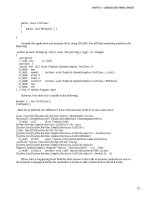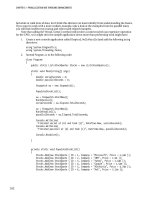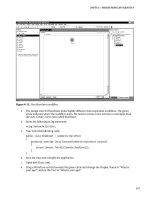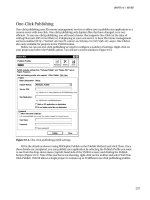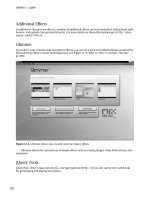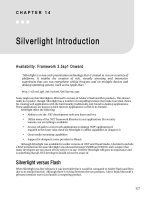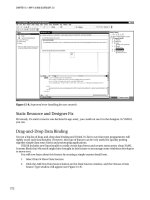4 4 exploring with james cook
Bạn đang xem bản rút gọn của tài liệu. Xem và tải ngay bản đầy đủ của tài liệu tại đây (2.68 MB, 10 trang )
EXPLORING
with James
Cook
Fascinating Facts
• Two United States space shuttles—the
Endeavour and the Discovery—were named
after ships used in James Cook’s voyages.
• A piece of wood that may have come from James
Cook’s first ship, the Endeavour, was carried into
space aboard the space shuttle Endeavour.
• Cook’s reports and drawings from his voyages
are so detailed that people still study them
today to learn about the places that he
traveled.
Genre
Nonfiction
Comprehension Skill
Summarize
Text Features
• Maps
• Captions
• Sidebar
Scott Foresman Social Studies
ISBN 0-328-14855-5
ì<(sk$m)=beif e< +^-Ä-U-Ä-U
by Cynthia Clampitt
In this book you will learn about Captain James
Cook. Cook is thought by many to have been one
of the world’s greatest explorers. He explored the
coasts of North America, many Pacific Islands,
New Zealand, and Australia. He was also a
scientist, a writer, and a mapmaker.
Vocabulary
WriteEXPLORING
to It!
James Cook
Captainwith
Cook was perhaps one of the
world’s greatest explorers. However, people
have always loved to explore. Write one
or two paragraphs about why you think
people like to explore. If you wish, you
might also describe something that is being
explored today and why.
scurvy
voyage
Write your ideas on a separate sheet of paper.
latitude
equator
Northern Hemisphere
Southern Hemisphere
longitude
frigid
Photographs
Every effort has been made to secure permission and provide appropriate credit for photographic material.
The publisher deeply regrets any omission and pledges to correct errors called to its attention in subsequent editions.
Unless otherwise acknowledged, all photographs are the property of Scott Foresman, a division of Pearson Education.
by Cynthia Clampitt
Photo locators denoted as follows: Top (T), Center (C), Bottom (B), Left (L), Right (R) Background (Bkgd).
ISBN: 0-328-14855-5
Copyright © Pearson Education, Inc. All Rights Reserved. Printed in the
United States of America. This publication or parts thereof may be used with appropriate
equipment to reproduce copies for classroom use only.
1 2 3 4 5 6 7 8 9 10 V0G1 14 13 12 11 10 09 08 07 06 05
Opener: Corbis
2 Alan Curtis/Alamy Images
3 (B1) ©Luny, Thomas/Bridgeman Art Library, (B2) Getty Images
5 (T1) Queen Elizabeth II Library/Centre for Newfoundland Studies, Memorial University Libraries, (T2) Getty Images
6 (B1) The Granger Collection, NY, (B2) Getty Images
7 Hodges, William/National Maritime Museum, London, UK/Bridgeman Art Library
8 (T) Corbis, (B) Nicky Needham ©Stamp reproduced by kind permission of New Zealand Post Limited from their 1940 Centennial
Stamp Issue.
Editorial Offices: Glenview, Illinois • Parsippany, New Jersey • New York, New York
11 Corbis
12 (T1) Corbis, (T2) Getty Images
Sales Offices: Needham, Massachusetts • Duluth, Georgia • Glenview, Illinois
13 Digital Vision
Coppell, Texas • Sacramento, California • Mesa, Arizona
14 ©Robert Y. Ono/Corbis
15 Neil Setchfield/Alamy Images
When James Cook was sixteen, he got a job at a store
in a nearby village. The village was close to Whitby, a
busy port filled with ships. Cook watched the ships come
in and out of the port. He talked to the sailors. He studied
anything he thought might help him if he ever had the
chance to go to sea.
Cook did a good job at the store, but the shopkeeper
could see that Cook was more interested in the ships. After
a year and a half, the shopkeeper introduced Cook to a
ship owner in Whitby. Cook’s life at sea had begun.
James Cook was born in a cottage in northern England
similar to this one.
James Cook’s Childhood
James Cook’s father was a poor farmworker from
Scotland. He had moved to northern England to find
work. His son James was born in a small farming village
on October 27, 1728.
A farmer who had hired James’s father noticed how
smart James was. The farmer offered to send James to
school. From the age of eight to the age of twelve, James
studied reading, writing, and arithmetic. He still had to
help his father on the farm, but he spent his free time
studying. He loved learning—and learning would be
something he did for the rest of his life.
2
In the English town of Whitby, Cook first came in contact
with ships and the sea.
3
Cook’s First Years at Sea
Cook spent the next eight years learning about ships
and sailing. The Whitby ships sailed the dangerous waters
of the North Sea. Learning to sail here prepared Cook to
sail anywhere.
Cook’s skills and knowledge grew. He was offered a
promotion in Whitby, but he thought that Britain’s navy
would give him more chances to see the world.
Life in the navy was not easy. Ships were crowded and
trips were long. Many men died of scurvy, a disease
caused by a lack of vitamin C. Cook obeyed orders and
worked hard. Soon he had command of his own ship.
James Cook learned to make accurate maps, such as this one of
Newfoundland.
The Seven Years’ War
The Seven Years’ War lasted from 1756 to 1763.
All of the major European powers of that time took
part in it. While much of the war happened in Europe,
some of it was fought in North America. The North
American part of the war actually began in 1754. This
war is known in the United States as the French and
Indian War.
4
The Seven Years’ War began in 1756. In 1757 Cook
was sent to Canada. There he met a man who taught
him the science of surveying. Surveying is the careful
measuring of the size, shape, and location of places.
Surveying was a new science, but Cook knew that it
would become an important one. He studied hard and
was soon a skilled surveyor. Cook’s survey of the St.
Lawrence River helped Britain win an important battle in
Quebec, Canada. Cook began surveying full-time. From
1763 to 1768, he surveyed eastern Canada and created
detailed maps.
5
Let the Exploration Begin
Cook was an excellent surveyor and mapmaker. He
was also a scientist, a mathematician, an artist, and a
writer. A report that he wrote about the Sun and Moon
made people realize he could do more than sail a ship.
His life was about to change. He was about to become an
explorer too.
Many people in Britain thought that exploring the
unknown parts of the world was important. James Cook
was perfect for this work. Cook was asked to make a long
voyage, or journey by sea, to the far side of the world.
This British map shows the routes of Cook’s three voyages
of exploration.
6
In Tahiti people who lived there paddled their canoes out to greet Cook’s
ship.
In August 1768 James Cook set sail on the Endeavour.
Cook made sure his ship was clean and his crew had a
healthy diet. He believed that if his men ate the right food,
they would not die of scurvy.
First Cook would sail to Tahiti to observe the planet
Venus passing in front of the Sun. Measuring this would
make it possible to mathematically figure out the distance
between Earth and the Sun. Then Cook and his crew were
to explore the southern latitudes, to see if there was
another continent south of the equator.
7
After his project in Tahiti was
finished, Cook found New Zealand.
He charted New Zealand’s entire
coast. Six months later, he came to
the east coast of Australia. Cook
charted this 2,000-mile-long coast as
well. Many discoveries were made.
The botanists, or plant scientists,
on the voyage found so many new
plants in one place that Cook named
the spot Botany Bay.
Finally, in 1771, the Endeavour
headed back toward England. All of Cook’s achievements
were important, but one was a real surprise: In three
years at sea, Cook had not lost anyone to scurvy. This had
never happened before. Cook’s ideas about health and
diet had been right.
This stamp from 1940 shows
Cook, his ship, and Cook’s
chart of New Zealand.
8
This picture was created by an artist on Cook’s second voyage. Cook’s
ship is seen among icebergs near Antarctica.
Cook’s Second Voyage
In the 1700s many people in the Northern
Hemisphere believed that there must be another
continent in the Southern Hemisphere. Cook was
asked to go on another voyage.
Cook departed in July 1772. He took with him the
first clock that would work on a ship. This clock made
it possible for Cook to figure out longitude. Longitude
had never been accurately measured before. Figuring
out longitude helped Cook identify the location of many
places.
9
On this voyage, Cook commanded the Resolution. He
sailed south from England, into the frigid waters around
Antarctica. Cook and his crews were the first people to
travel south of the Antarctic Circle.
Cook felt certain that there was land under the ice. He
also believed that this was the last continent that would be
discovered in the Southern Hemisphere. He was right.
As Cook sailed closer to Antarctica, the terrible cold
froze the ships’ ropes and sails. Surrounded by broken ice
and towering icebergs, the ships were in danger of being
crushed. Cook’s ships and his crews sailed to within one
hundred miles of the coast of Antarctica, but were forced
to give up.
Cook headed into the South Pacific, where he found
and mapped many unfamiliar islands. After a few more
months, he turned back toward Antarctica. He sailed all
the rest of the way around the frozen continent before
heading back to England.
Cook reached home in July 1775. This second voyage
had taken more than three years and had covered seventy
thousand miles.
10
James Cook wrote about all the places he traveled.
11
Captain Cook again sailed on the Resolution. There was
also a second ship, the Discovery. The two ships sailed
below Africa and into the Pacific Ocean. Traveling north,
Cook found many new islands, including the Hawaiian
Islands. The ships stopped in Hawaii for supplies. The
island people seemed friendly and happy to trade for
food.
From Hawaii, Cook sailed to North America. He
explored the coast of what is now Oregon, Washington,
and Alaska. Traveling up the coast, Cook and his crew
met many new people.
James Cook spent most of his adult life sailing the
world’s oceans.
Cook’s Final Voyage
In the 1700s people still wondered whether there was
an ocean passage above North America connecting the
Atlantic and Pacific Oceans. Cook was now forty-seven
years old. He had spent nearly thirty years at sea. He was
tired and his health was not good. Could he be asked to
lead another expedition?
Cook understood how important the discovery of a
Northwest Passage would be to Britain. He agreed to
command this voyage and departed in July 1776.
12
Views like this would have greeted Cook and his crew as they
sailed along the coast of Alaska.
13
Captain Cook sailed to the Hawaiian Islands on his third voyage.
Cook sailed through the Aleutian Islands, the string of
islands in Alaska’s far west. From here, he sailed into the
Arctic Ocean. Ahead of him were massive walls of ice.
Cook got as close to the ice walls as he could. But there
was no passage through to the Atlantic, only great danger
from the moving ice. Disappointed, Cook turned west,
where he charted part of the coast of Siberia.
Winter was coming. Cook felt that warm weather
would be healthy for his crew. It was a difficult decision,
but Cook and his men returned to Hawaii.
14
In January of the next year, Cook again sailed north.
He still wanted to try to find a way through the Arctic
Ocean.
When one of the ships was damaged in a storm, he
was forced to return to Hawaii. This time the Hawaiians
were not happy to see Cook and his men. On February
14, 1779, several Hawaiian warriors met Cook on the
beach and killed him. Cook’s saddened
crew sailed back to England with the
news.
James Cook is still honored today
in many countries. Some people
consider him to be the world’s
greatest explorer.
This statue of James Cook stands in
London, England.
15
In this book you will learn about Captain James
Cook. Cook is thought by many to have been one
Glossary
of the world’s greatest explorers. He explored the
equator the imaginary line that circles the center
coasts
of North America, many Pacific Islands,
of
Earth from
east
to west He was also a
New Zealand,
and
Australia.
scientist,
a writer,
frigid very
cold and a mapmaker.
latitude the measurement of how far north or
south of the equator
a place is located
Vocabulary
longitude the measurement
scurvy of how far
east or west of the prime meridian a place is
voyage
located
latitude
Northern Hemisphere the half of Earth north
equator
of the equator
Northern Hemisphere
scurvy a disease caused by a lack of
vitamin C Southern Hemisphere
longitude
Southern Hemisphere
the half of Earth south
of the equator
frigid
voyage a journey by sea
Write to It!
Captain Cook was perhaps one of the
world’s greatest explorers. However, people
have always loved to explore. Write one
or two paragraphs about why you think
people like to explore. If you wish, you
might also describe something that is being
explored today and why.
Write your ideas on a separate sheet of paper.
Photographs
Every effort has been made to secure permission and provide appropriate credit for photographic material.
The publisher deeply regrets any omission and pledges to correct errors called to its attention in subsequent editions.
Unless otherwise acknowledged, all photographs are the property of Scott Foresman, a division of Pearson Education.
Photo locators denoted as follows: Top (T), Center (C), Bottom (B), Left (L), Right (R) Background (Bkgd).
ISBN: 0-328-14855-5
Copyright © Pearson Education, Inc. All Rights Reserved. Printed in the
United States of America. This publication or parts thereof may be used with appropriate
equipment to reproduce copies for classroom use only.
1 2 3 4 5 6 7 8 9 10 V0G1 14 13 12 11 10 09 08 07 06 05
16
Opener: Corbis
2 Alan Curtis/Alamy Images
3 (B1) ©Luny, Thomas/Bridgeman Art Library, (B2) Getty Images
5 (T1) Queen Elizabeth II Library/Centre for Newfoundland Studies, Memorial University Libraries, (T2) Getty Images
6 (B1) The Granger Collection, NY, (B2) Getty Images
7 Hodges, William/National Maritime Museum, London, UK/Bridgeman Art Library
8 (T) Corbis, (B) Nicky Needham ©Stamp reproduced by kind permission of New Zealand Post Limited from their 1940 Centennial
Stamp Issue.
11 Corbis
12 (T1) Corbis, (T2) Getty Images
13 Digital Vision
14 ©Robert Y. Ono/Corbis
15 Neil Setchfield/Alamy Images

